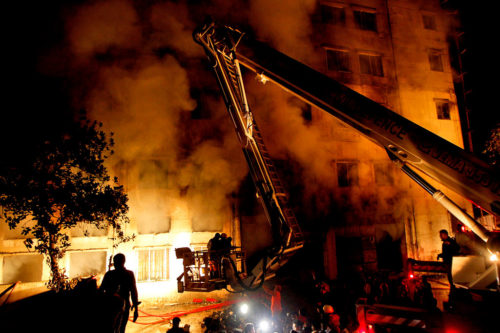With an annual revenue of nearly $500 billion, Walmart is the world’s largest retailer, sourcing consumer goods from thousands of suppliers around the globe. By offering products to consumers at rock-bottom prices, Walmart has successfully positioned itself as the leading low-cost retailer. The company has pioneered a business approach in which it uses its vast market power to drive down prices, threatening to terminate suppliers if they can’t meet the retailer’s strict demands for low-cost products. Walmart has honed this strategy so sharply that it has come to be known as “the Walmart model.” But this model comes at a steep price for workers.

112 workers were killed in the fire at Tazreen Fashions. The factory lacked proper fire exits, yet Walmart and other buyers failed to implement the necessary repairs. Credit: Hasan Raza, Associated Press.
On November 24, 2012, a fire at the Tazreen Fashions factory in Bangladesh killed 112 workers and injured more than 200, making it the deadliest fire in the country’s history. The circumstances surrounding the blaze were frustratingly similar to previous deadly fires in the Bangladesh garment industry: poor quality electrical wiring led to a short-circuit on the ground floor of the factory, where flammable materials caught fire. The flames spread quickly through the upper floors, and the lack of proper fire exits left workers trapped inside the burning building. Some workers died due to smoke inhalation, others died jumping from upper story windows as they tried to escape the blaze, and others burned to death in the flames.
At the time of the fire, the factory’s customers included Disney, Sears/Kmart, Dickies, Li & Fung, the Dutch company C&A, and Walmart. Although Walmart initially denied a relationship with the factory, evidence found onsite showed that Walmart’s in-house fashion line, Faded Glory, was being sewn there in the weeks leading up the tragedy.
Between 2011 and 2012, Walmart auditors visited the Tazreen factory at least three times and on at least one occasion, identified “violations and/or conditions which were deemed to be high risk,” for which the factory received an “orange” rating. These violations included a “lack of fire alarms in many areas, a shortage of fire extinguishers and obstacles blocking workers’ escape routes.” Although Walmart’s inspections did not specifically look at whether the factory had functional emergency exits, any competent inspector should have been able to see that Tazreen lacked proper fire exits and that the building’s stairwells led directly to the ground floor, instead of outside. Rather than correcting these hazards, which likely would have prevented a significant loss of life in the subsequent fire, Walmart removed Tazreen from its list of approved factories at some point during 2012.
Nonetheless, several Walmart suppliers continued sourcing from the facility. When reporters contacted the company about its relationship with Tazreen in the wake of the fire, Walmart claimed that the factory “was no longer authorized to produce merchandise for Walmart” and stated that a supplier had “subcontracted work to this factory without authorization and in direct violation of our policies.” But documents found at the scene showed that at least three different Walmart suppliers were sourcing from the factory even after Walmart supposedly removed Tazreen from its list of approved suppliers.
In a country known for its history of deadly fires and building collapses, it almost defies reason that Walmart, the single largest buyer from Bangladesh, was not adequately monitoring or implementing fire and building safety standards at its suppliers. The company was fully aware of the risks. In April 2011, a meeting was held in Dhaka between global brands, Bangladeshi suppliers, government representatives, and civil society organizations to discuss the ongoing safety crisis in the country’s apparel industry. According to the official record of the meeting, Walmart’s representative stated that the improvements being discussed would be “in most cases” a “very extensive and costly modification.” More than 18 months before the Tazreen fire, Walmart was acknowledging that most of its Bangladesh factories were in need of major repairs and renovations.
Yet the company did nothing. According to an internal email from a Walmart executive in December 2012, “Fire and electrical safety aspects are not currently covered in ethical sourcing audits.” And at the April 2011 meeting in Dhaka, Walmart refused to take financial responsibility for making its factories safe, stating, “It is not financially feasible for the brands to make such investments.” Publicly, however, Walmart was reassuring consumers that it would “not buy from an unsafe factory.” It is deeply disturbing to consider that Walmart knew about the deadly hazards at its Bangladesh suppliers and did nothing to fix them. If it had, perhaps those workers who died in the Tazreen fire might still be alive today.
The empty promises of CSR have failed to protect workers the world over, and Walmart’s supply chain is no exception. Left to their own devices, corporations will always refuse to relinquish any control over their supply chain or devote any of their revenue to improvements for workers. This is why such commitments must take the form of legally binding agreements, enforced through strict market consequences and implemented as part of a WSR program.
It wasn’t until the Accord on Fire and Building Safety, a strong example of WSR at work, was implemented in Bangladesh that garment factories there began to undergo investigations by skilled inspectors, and that life-saving repairs began to be made. Unfortunately, Walmart, along with Gap Inc., another prominent US buyer from Bangladesh, has refused to join the Accord. Instead, these companies have chosen to form their own voluntary initiative, the Alliance for Bangladesh Worker Safety, which lacks virtually all of the elements necessary for an inspection and remediation program to be effective.